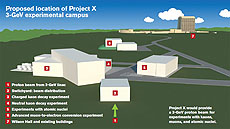Scientists present staged plans for Project X
 |
Throughout its stages, Project X could provide beam for more than 20 experiments. Image: Fermilab |
Members of the team planning the accelerator project that will power Fermilab's future experiments announced this week that they have developed ways to construct the project in three stages.
With their eyes on the tight federal budget, scientists plan to divide the endeavor, Project X, into phases in order to lessen its annual costs. Last month, the U.S. Department of Energy asked Fermilab to look into ways to build the proposed Long Baseline Neutrino Experiment in stages for the same reason.
"As much as we'd like to have the full Project X at one time, we respect that funding cannot support that," said Bob Tschirhart, project scientist for the research program. In total, Project X will cost between $1 billion and $2 billion.
Project X scientists will present a series of three talks, starting today, in part to explain the new plan.
Today at 4 p.m., Shekhar Mishra, head of international coordination for Project X, will give a wine & cheese seminar to the Fermilab scientific community that will also provide updates on the laboratory's collaboration with Indian institutions.
On Tuesday, May 8, Project X Project Manager Steve Holmes will give an accelerator physics and technology seminar to outline the planned staging of Project X and to discuss related R&D issues.
On Wednesday, May 9, Tschirhart will give a general colloquium to the Fermilab community at large about how Project X could help scientists achieve their goals in research at the Intensity Frontier and advance accelerator technology in the United States.
Project X is a proposed proton accelerator complex that could throughout its stages provide beam for more than 20 experiments. According to a study, Project X experiments could support 1,500 to 2,000 users from around the world, roughly the same number who worked on experiments at Fermilab's now-closed Tevatron accelerator.
—Kathryn Grim
|